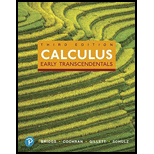
In Example 3, does the rock have a greater speed at t = 1 or t = 3?
Example 3 Motion in a Gravitational Field
Suppose a stone is thrown vertically upward with an initial velocity of 64 ft/s from a bridge 96 ft above a river. By Newton’s laws of motion, the position of the stone (measured as the height above the river) after t seconds is
where s = 0 is the level of the river (Figure 3.45a).
- The position function in Example 3 is derived in Section 6.1. Once again we mention that the graph of the position function is not the path of the stone.
- a. Find the velocity and acceleration functions.
- b. What is the highest point above the river reached by the stone?
- c. With what velocity will the stone strike the river?
Want to see the full answer?
Check out a sample textbook solution
Chapter 3 Solutions
Calculus: Early Transcendentals and MyLab Math with Pearson eText -- Title-Specific Access Card Package (3rd Edition) (Briggs, Cochran, Gillett & Schulz, Calculus Series)
Additional Math Textbook Solutions
Intro Stats, Books a la Carte Edition (5th Edition)
Thinking Mathematically (6th Edition)
Introductory Statistics
Elementary Statistics
Elementary Statistics: Picturing the World (7th Edition)
- Please refer belowarrow_forwardPlease refer belowarrow_forwardHi, can you guys help me with this? Thank you! Can you guys help me calculate again the Term GPA, Combined GPA, Cumulative GPA, Transfer GPA & Combined Cumulative GPA section? It's just not right right now. Here's the transfer totals point that I want to provide just in case you guys may ask where I get these from:arrow_forward
- Consider the functions f(x)=4x-1 and g(x)=sq root of -x+7. Determine 1. f o g(x) 2. Give the domain of f o g(x) 3. g o f (x) 4. Give the domain of g o f(x)arrow_forward12. lim h→0 √5x+5h -√5x h where x>0 is constaarrow_forwardLet f(x)=sq root of x+5 and g(x)=x2 -2. 1. The composite function g of f(x) = 2. The domain of g o f(x) in interval notation isarrow_forward

 Linear Algebra: A Modern IntroductionAlgebraISBN:9781285463247Author:David PoolePublisher:Cengage LearningAlgebra & Trigonometry with Analytic GeometryAlgebraISBN:9781133382119Author:SwokowskiPublisher:Cengage
Linear Algebra: A Modern IntroductionAlgebraISBN:9781285463247Author:David PoolePublisher:Cengage LearningAlgebra & Trigonometry with Analytic GeometryAlgebraISBN:9781133382119Author:SwokowskiPublisher:Cengage
 Functions and Change: A Modeling Approach to Coll...AlgebraISBN:9781337111348Author:Bruce Crauder, Benny Evans, Alan NoellPublisher:Cengage Learning
Functions and Change: A Modeling Approach to Coll...AlgebraISBN:9781337111348Author:Bruce Crauder, Benny Evans, Alan NoellPublisher:Cengage Learning




